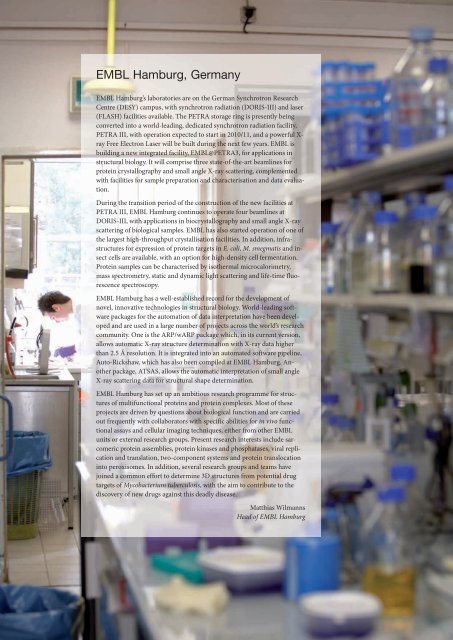Create successful ePaper yourself
Turn your PDF publications into a flip-book with our unique Google optimized e-Paper software.
<strong>EMBL</strong> Hamburg, Germany<br />
<strong>EMBL</strong> Hamburg’s laboratories are on the German Synchrotron Research<br />
Centre (DESY) campus, with synchrotron radiation (DORIS-III) and laser<br />
(FLASH) facilities available. The PETRA storage ring is presently being<br />
converted into a world-leading, dedicated synchrotron radiation facility,<br />
PETRA III, with operation expected to start in 2010/11, and a powerful X-<br />
ray Free Electron Laser will be built during the next few years. <strong>EMBL</strong> is<br />
building a new integrated facility, <strong>EMBL</strong>@PETRA3, for applications in<br />
structural biology. It will comprise three state-of-the-art beamlines for<br />
protein crystallography and small angle X-ray scattering, complemented<br />
with facilities for sample preparation and characterisation and data evaluation.<br />
During the transition period of the construction of the new facilities at<br />
PETRA III, <strong>EMBL</strong> Hamburg continues to operate four beamlines at<br />
DORIS-III, with applications in biocrystallography and small angle X-ray<br />
scattering of biological samples. <strong>EMBL</strong> has also started operation of one of<br />
the largest high-throughput crystallisation facilities. In addition, infrastructures<br />
for expression of protein targets in E. coli, M. smegmatis and insect<br />
cells are available, with an option for high-density cell fermentation.<br />
Protein samples can be characterised by isothermal microcalorimetry,<br />
mass spectrometry, static and dynamic light scattering and life-time fluorescence<br />
spectroscopy.<br />
<strong>EMBL</strong> Hamburg has a well-established record for the development of<br />
novel, innovative technologies in structural biology. World-leading software<br />
packages for the automation of data interpretation have been developed<br />
and are used in a large number of projects across the world’s research<br />
community. One is the ARP/wARP package which, in its current version,<br />
allows automatic X-ray structure determination with X-ray data higher<br />
than 2.5 Å resolution. It is integrated into an automated software pipeline,<br />
Auto-Rickshaw, which has also been compiled at <strong>EMBL</strong> Hamburg. Another<br />
package, ATSAS, allows the automatic interpretation of small angle<br />
X-ray scattering data for structural shape determination.<br />
<strong>EMBL</strong> Hamburg has set up an ambitious research programme for structures<br />
of multifunctional proteins and protein complexes. Most of these<br />
projects are driven by questions about biological function and are carried<br />
out frequently with collaborators with specific abilities for in vivo functional<br />
assays and cellular imaging techniques, either from other <strong>EMBL</strong><br />
units or external research groups. Present research interests include sarcomeric<br />
protein assemblies, protein kinases and phosphatases, viral replication<br />
and translation, two-component systems and protein translocation<br />
into peroxisomes. In addition, several research groups and teams have<br />
joined a common effort to determine 3D structures from potential drug<br />
targets of Mycobacterium tuberculosis, with the aim to contribute to the<br />
discovery of new drugs against this deadly disease.<br />
Matthias Wilmanns<br />
Head of <strong>EMBL</strong> Hamburg













